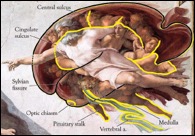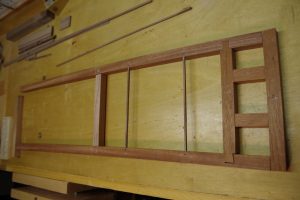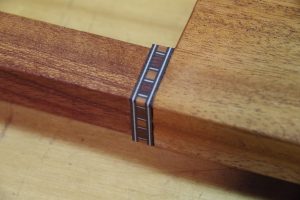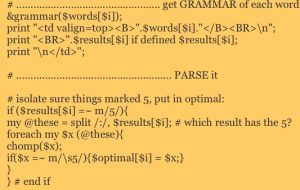The case of Maldon

During an Independent Study on the Battle of Maldon this week, we noticed that in lines 109 and 110, the weapons of war were named in the third lift. The verbs were in the fourth:
grimme gegrundene garas fleogan
bogan wæran bysige bord ord onfeng.
A lift is another term for one of the four heavily weighted syllables in the OE poetic line. Whether some have more semantic force than others is a question raised by Professor Smirnitskaya of Moscow State University. Her student, Dr. Ilya Sverdlov of the Helsinki Institute of Advanced Study, gave a terrific paper on lifts and semantic force here at UMass many years ago.
I wrote a program to extract the third lift from every line. Recall that every OE poetic line has four major stresses, a caesura between the second and third stress, and alliteration across the caesura.
The program is in Python. For each line of the poem:
- I remove OE stop-words
- divide a line into half-lines (called the a-line and the b-line)
- take the first letter of each word in the a-line in order to establish a pattern of alliteration in the b-line
- return the third lift
At the moment, the third lift is unformatted. But I’d like to format it in color if it’s an alliterated lift. That’s for later. Also for later is adding some functionality so that this program can retrieve any lift from any poem along with the part of speech of that lift (e.g. “garas”, noun plural). First, the results. Then, the code. NB. Some of the results are inaccurate—I’ve marked those with a Kleene star.
1 ['not', 'line'], ['brocen', 'wurde.'] brocen 2 ['het', 'hyssa', 'hwæne'], ['hors', 'forlætan,'] hors 3 ['feor', 'afysan'], ['forð', 'gangan,'] forð 4 ['hicgan', 'handum'], ['hige', 'godum.'] hige 5 ['offan', 'mæg'], ['ærest', 'onfunde'] onfunde* 6 ['eorl', 'nolde'], ['yrhðo', 'geþolian,'] yrhðo 7 ['let', 'handon'], ['leofne', 'fleogan'] leofne 8 ['hafoc', 'holtes'], ['hilde', 'stop.'] hilde 9 ['man', 'mihte', 'oncnawan'], ['cniht', 'nolde'] cniht 10 ['wacian', 'wige'], ['wæpnum', 'feng.'] wæpnum 11 ['wolde', 'eadric'], ['ealdre', 'gelæstan'] ealdre 12 ['frean', 'gefeohte;'], ['ongan', 'forð', 'beran'] forð 13 ['gar', 'guþe.'], ['hæfde', 'god', 'geþanc'] god 14 ['handum'], ['healdan', 'mihte'] healdan 15 ['bord', 'brad', 'swurd;'], ['beot', 'gelæste'] beot 16 ['ætforan', 'frean'], ['feohtan', 'sceolde.'] feohtan 17 ['þær', 'byrhtnoð', 'ongan'], ['beornas', 'trymian,'] beornas 18 ['rad', 'rædde,'], ['rincum', 'tæhte'] rincum 19 ['hu', 'sceoldon', 'standan'], ['þone', 'stede', 'healdan'] stede 20 ['bæd', 'hyra', 'randas'], ['rihte', 'heoldon'] rihte 21 ['fæste', 'folman'], ['forhtedon', 'na.'] forhtedon 22 ['hæfde', 'folc'], ['fægere', 'getrymmed,'] fægere 23 ['lihte', 'leodon'], ['þær', 'leofost', 'wæs,'] leofost 24 ['þær', 'heorðwerod'], ['holdost', 'wiste.'] holdost 25 ['stod', 'stæðe,'], ['stiðlice', 'clypode'] stiðlice 26 ['wicinga', 'ar,'], ['wordum', 'mælde;'] wordum 27 ['beot', 'abead'], ['brimliþendra'] brimliþendra 28 ['ærænde', 'eorle'], ['þær', 'ofre', 'stod:'] þær* 29 ['sendon'], ['sæmen', 'snelle,'] sæmen 30 ['heton', 'secgan'], ['most', 'sendan', 'raðe'] sendan 31 ['beagas', 'gebeorge;'], ['betere', 'is'] betere 32 ['þisne', 'garræs'], ['gafole', 'forgyldon'] gafole 33 ['þonne', 'hearde'], ['hilde', 'dælon.'] hilde 34 ['þurfe', 'spillan'], ['spedaþ', 'þam;'] spedaþ 35 ['willað', 'golde'], ['grið', 'fæstnian.'] grið 36 ['gyf', 'gerædest'], ['her', 'ricost', 'eart'] her 37 ['þine', 'leoda'], ['lysan', 'wille,'] lysan 38 ['syllan', 'sæmannum'], ['hyra', 'sylfra', 'dom'] sylfra 39 ['feoh', 'freode'], ['niman', 'frið', 'us,'] frið 40 ['willaþ', 'sceattum'], ['scype', 'gangan,'] scype 41 ['flot', 'feran'], ['friþes', 'healdan.'] friþes 42 ['byrhtnoð', 'maþelode,'], ['bord', 'hafenode,'] bord 43 ['wand', 'wacne', 'æsc,'], ['wordum', 'mælde,'] wordum 44 ['yrre', 'anræd'], ['ageaf', 'andsware:'] ageaf 45 ['gehyrst', 'þu,', 'sælida,'], ['folc', 'segeð?'] segeð* 46 ['willað', 'gafole'], ['garas', 'syllan'] garas 47 ['ættrynne', 'ord'], ['ealde', 'swurd,'] ealde 48 ['heregeatu'], ['hilde', 'deah.'] hilde 49 ['brimmanna', 'boda,'], ['abeod', 'ongean:'] abeod 50 ['sege', 'þinum', 'leodum'], ['miccle', 'laþre', 'spell,'] laþre 51 ['her', 'stynt', 'unforcuð'], ['eorl', 'werode'] eorl 52 ['wile', 'gealgean'], ['eþel', 'þysne,'] eþel 53 ['æþelredes', 'eard'], ['ealdres', 'mines'] ealdres 54 ['folc', 'foldan.'], ['feallan', 'sceolon'] feallan 55 ['hæþene', 'hilde!'], ['heanlic', 'þinceð'] heanlic 56 ['urum', 'sceattum'], ['scype', 'gangon'] scype 57 ['unbefohtene,'], ['þus', 'feor', 'hider'] þus* 58 ['urne', 'eard'], ['becomon.'] becomon* 59 ['sceole', 'softe'], ['sinc', 'gegangan;'] sinc 60 ['sceal', 'ord', 'ecg'], ['geseman'] geseman 61 ['grim', 'guðplega'], ['gofol', 'syllon.'] gofol 62 ['het', 'bord', 'beran,'], ['beornas', 'gangan'] beornas 63 ['easteðe'], ['ealle', 'stodon.'] ealle 64 ['mihte', 'þær', 'wætere'], ['werod', 'oðrum;'] werod 65 ['þær', 'com', 'flowende'], ['flod', 'ebban,'] flod 66 ['lucon', 'lagustreamas.'], ['lang', 'þuhte'] lang 67 ['hwænne', 'togædere'], ['garas', 'beron.'] garas 68 ['þær', 'pantan', 'stream'], ['prasse', 'bestodon'] prasse 69 ['eastseaxena', 'ord'], ['æschere.'] æschere. 70 ['mihte', 'hyra', 'ænig'], ['oþrum', 'derian'] oþrum 71 ['flanes', 'flyht'], ['fyl', 'gename.'] fyl 72 ['flod', 'ut', 'gewat.'], ['flotan', 'stodon', 'gearowe'] flotan 73 ['wicinga', 'fela,'], ['wiges', 'georne.'] wiges 74 ['het', 'hæleða', 'hleo'], ['healdan', 'bricge'] healdan 75 ['wigan', 'wigheardne,'], ['wæs', 'haten', 'wulfstan,'] wæs 76 ['cafne', 'cynne;'], ['wæs', '?eolan', 'sunu'] ?eolan 77 ['ðone', 'forman', 'man'], ['francan', 'ofsceat'] francan 78 ['þær', 'baldlicost'], ['bricge', 'stop.'] bricge 79 ['þær', 'stodon', 'wulfstane'], ['wigan', 'unforhte,'] wigan 80 ['ælfere', 'maccus,'], ['modige', 'twegen,'] modige 81 ['noldon', 'forda'], ['fleam', 'gewyrcan,'] fleam 82 ['fæstlice'], ['fynd', 'weredon'] fynd 83 ['wæpna'], ['wealdan', 'moston.'] wealdan 84 ['ongeaton'], ['georne', 'gesawon'] georne 85 ['þær', 'bricgweardas'], ['bitere', 'fundon,'] bitere 86 ['ongunnon', 'lytegian'], ['laðe', 'gystas:'] laðe 87 ['bædon', 'upgang'], ['agan', 'moston,'] agan 88 ['þone', 'ford', 'faran,'], ['feþan', 'lædan.'] feþan 89 ['eorl', 'ongan'], ['ofermode'] ofermode 90 ['alyfan', 'landes', 'fela'], ['laþere', 'ðeode.'] laþere 91 ['ongan', 'ceallian'], ['cald', 'wæter'] cald 92 ['byrhtelmes', 'bearn'], ['beornas', 'gehlyston:'] beornas 93 ['is', 'gerymed;'], ['gað', 'ricene', 'us,'] gað 94 ['guman', 'guþe.'], ['god', 'ana', 'wat'] god 95 ['wælstowe'], ['wealdan', 'mote.'] wealdan 96 ['wodon', 'wælwulfas'], ['wætere', 'murnon,'] wætere 97 ['wicinga', 'werod'], ['west', 'pantan,'] west 98 ['scir', 'wæter'], ['scyldas', 'wegon,'] scyldas 99 ['lidmen', 'lande'], ['linde', 'bæron.'] linde 100 ['þær', 'ongean', 'gramum'], ['gearowe', 'stodon'] gearowe 101 ['byrhtnoð', 'beornum;'], ['bordum', 'het'] bordum 102 ['wyrcan', 'þone', 'wihagan'], ['werod', 'healdan'] werod 103 ['fæste', 'feondum.'], ['wæs', 'feohte', 'neh'] feohte 104 ['tir', 'getohte.'], ['wæs', 'tid', 'cumen'] tid 105 ['þær', 'fæge', 'men'], ['feallan', 'sceoldon.'] feallan 106 ['þær', 'wearð', 'hream', 'ahafen.'], ['hremmas', 'wundon,'] hremmas 107 ['earn', 'æses', 'georn.'], ['wæs', 'eorþan', 'cyrm.'] eorþan 108 ['leton', 'folman'], ['feolhearde', 'speru,'] feolhearde 109 ['gegrundene'], ['garas', 'fleogan.'] garas 110 ['bogan', 'wæron', 'bysige;'], ['bord', 'ord', 'onfeng.'] bord 111 ['biter', 'wæs', 'beaduræs.'], ['beornas', 'feollon'] beornas 112 ['gehwæðere', 'hand,'], ['hyssas', 'lagon.'] hyssas 113 ['wund', 'wearð', 'wulfmær,'], ['wælræste', 'geceas'] wælræste 114 ['byrhtnoðes', 'mæg;'], ['billum', 'wearð'] billum 115 ['swuster', 'sunu'], ['swiðe', 'forheawen.'] swiðe 116 ['þær', 'wearð', 'wicingum'], ['wiþerlean', 'agyfen.'] wiþerlean 117 ['gehyrde', 'eadweard'], ['anne', 'sloge'] anne 118 ['swiðe', 'swurde,'], ['swenges', 'wyrnde'] swenges 119 ['fotum', 'feoll'], ['fæge', 'cempa.'] fæge 120 ['ðeoden'], ['þanc', 'gesæde'] þanc 121 ['burþene'], ['byre', 'hæfde.'] byre 122 ['stemnetton'], ['stiðhicgende'] stiðhicgende 123 ['hysas', 'hilde;'], ['hogodon', 'georne'] hogodon 124 ['þær', 'orde'], ['ærost', 'mihte'] ærost 125 ['fægean', 'men'], ['feorh', 'gewinnan,'] feorh 126 ['wigan', 'wæpnum.'], ['wæl', 'feol', 'eorðan.'] wæl 127 ['stodon', 'stædefæste;'], ['stihte', 'byrhtnoð,'] stihte 128 ['bæd', 'hyssa', 'gehwylc'], ['hogode', 'wige'] hogode 129 ['denon', 'wolde'], ['dom', 'gefeohtan.'] dom 130 ['wod', 'wiges', 'heard,'], ['wæpen', 'up', 'ahof,'] wæpen 131 ['bord', 'gebeorge,'], ['beornes', 'stop.'] beornes 132 ['eode', 'anræd'], ['eorl', 'ceorle;'] eorl 133 ['ægþer', 'hyra', 'oðrum'], ['yfeles', 'hogode.'] hogode* 134 ['sende', 'særinc'], ['suþerne', 'gar'] suþerne 135 ['gewundod', 'wearð'], ['wigena', 'hlaford.'] wigena 136 ['sceaf', 'scylde'], ['sceaft', 'tobærst'] sceaft 137 ['spere', 'sprengde'], ['sprang', 'ongean.'] sprang 138 ['gegremod', 'wearð', 'guðrinc;'], ['gare', 'stang'] gare 139 ['wlancne', 'wicing'], ['wunde', 'forgeaf.'] wunde 140 ['frod', 'wæs', 'fyrdrinc:'], ['let', 'francan', 'wadan'] francan 141 ['hysses', 'hals,'], ['hand', 'wisode'] hand 142 ['færsceaðan'], ['feorh', 'geræhte.'] feorh 143 ['oþerne'], ['ofstlice', 'sceat'] ofstlice 144 ['byrne', 'tobærst;'], ['wæs', 'breostum', 'wund'] breostum 145 ['hringlocan;'], ['heortan', 'stod'] heortan 146 ['ætterne', 'ord.'], ['eorl', 'wæs', 'bliþra;'] eorl 147 ['hloh', 'modi', 'man,'], ['sæde', 'metode', 'þanc'] metode 148 ['dægweorces'], ['drihten', 'forgeaf.'] drihten 149 ['forlet', 'drenga'], ['daroð', 'handa'] daroð 150 ['fleogan', 'folman'], ['forð', 'gewat'] forð 151 ['ðone', 'æþelan'], ['æþelredes', 'þegen.'] æþelredes 152 ['healfe', 'stod'], ['hyse', 'unweaxen,'] hyse 153 ['cniht', 'gecampe,'], ['full', 'caflice'] caflice 154 ['bræd', 'beorne'], ['blodigne', 'gar,'] blodigne 155 ['wulfstanes', 'bearn,'], ['wulfmær', 'geonga'] wulfmær 156 ['forlet', 'forheardne'], ['faran', 'ongean;'] faran 157 ['ord', 'gewod'], ['eorþan', 'læg'] eorþan 158 ['þeoden'], ['þearle', 'geræhte.'] þearle 159 ['eode', 'gesyrwed'], ['secg', 'eorle;'] eorle; 160 ['wolde', 'beornes'], ['beagas', 'gefetigan'] beagas 161 ['reaf', 'hringas'], ['gerenod', 'swurd.'] gerenod 162 ['byrhtnoð', 'bræd'], ['bill', 'sceðe'] bill 163 ['brad', 'bruneccg'], ['byrnan', 'sloh.'] byrnan 164 ['raþe', 'hine', 'gelette'], ['lidmanna'] lidmanna 165 ['eorles'], ['earm', 'amyrde.'] earm 166 ['feoll', 'foldan'], ['fealohilte', 'swurd;'] fealohilte 167 ['mihte', 'gehealdan'], ['heardne', 'mece,'] heardne, 168 ['wæpnes', 'wealdan.'], ['gyt', 'word', 'gecwæð'] word 169 ['har', 'hilderinc,'], ['hyssas', 'bylde,'] hyssas 170 ['bæd', 'gangan', 'forð'], ['gode', 'geferan;'] gode 171 ['mihte', 'fotum', 'leng'], ['fæste', 'gestandan.'] fæste 172 ['heofenum', 'wlat:'], ['no', 'half', 'line'] half 173 ['geþancie', 'þe,'], ['ðeoda', 'waldend,'] ðeoda 174 ['ealra', 'þæra', 'wynna'], ['worulde', 'gebad.'] worulde 175 ['ah,', 'milde', 'metod,'], ['mæste', 'þearfe'] mæste 176 ['minum', 'gaste'], ['godes', 'geunne'] godes 177 ['sawul'], ['siðian', 'mote'] siðian 178 ['geweald,'], ['þeoden', 'engla,'] þeoden 179 ['friþe', 'feran.'], ['eom', 'frymdi'] frymdi 180 ['helsceaðan'], ['hynan', 'moton.'] hynan 181 ['hine', 'heowon'], ['hæðene', 'scealcas'] hæðene 182 ['begen', 'beornas'], ['big', 'stodon:'] big 183 ['ælfnoð', 'wulmær'], ['begen', 'lagon'] begen 184 ['onemn', 'hyra', 'frean'], ['feorh', 'gesealdon.'] feorh 185 ['bugon', 'beaduwe'], ['þær', 'beon', 'noldon.'] beon 186 ['þær', 'wearð', 'oddan', 'bearn'], ['ærest', 'fleame'] ærest 187 ['godric', 'guþe'], ['þone', 'godan', 'forlet'] godan 188 ['mænigne'], ['mearh', 'gesealde.'] mearh 189 ['gehleop', 'þone', 'eoh'], ['ahte', 'hlaford'] ahte 190 ['gerædum'], ['riht', 'wæs,'] riht 191 ['broðru'], ['begen', 'ærndon,'] begen 192 ['godwine', 'godwig'], ['guþe', 'gymdon,'] guþe 193 ['wendon', 'wige'], ['þone', 'wudu', 'sohton,'] wudu 194 ['flugon', 'fæsten'], ['hyra', 'feore', 'burgon,'] feore 195 ['manna', 'ma'], ['þonne', 'ænig', 'mæð', 'wære'] mæð 196 ['gyf', 'geearnunga'], ['ealle', 'gemundon'] gemundon 197 ['duguþe'], ['gedon', 'hæfde.'] gedon 198 ['offa', 'dæg'], ['asæde'] asæde 199 ['meþelstede'], ['gemot', 'hæfde'] gemot 200 ['þær', 'modiglice'], ['manega', 'spræcon'] manega 201 ['þearfe'], ['þolian', 'noldon.'] þolian 202 ['wearð', 'afeallen'], ['folces', 'ealdor,'] folces 203 ['æþelredes', 'eorl;'], ['ealle', 'gesawon'] ealle 204 ['heorðgeneatas'], ['hyra', 'heorra', 'læg.'] hyra 205 ['ðær', 'wendon', 'forð'], ['wlance', 'þegenas,'] wlance 206 ['unearge', 'men'], ['efston', 'georne;'] efston 207 ['woldon', 'ealle'], ['oðer', 'twega,'] oðer 208 ['lif', 'forlætan'], ['oððe', 'leofne', 'gewrecan.'] leofne 209 ['bylde', 'forð'], ['bearn', 'ælfrices,'] bearn 210 ['wiga', 'wintrum', 'geong'], ['wordum', 'mælde;'] wordum 211 ['ælfwine', 'cwæð,'], ['ellen', 'spræc:'] ellen 212 ['gemunon', 'mæla'], ['meodo', 'spræcon,'] meodo 213 ['þonne', 'bence'], ['beot', 'ahofon'] beot 214 ['hæleð', 'healle,'], ['heard', 'gewinn.'] heard 215 ['mæg', 'cunnian'], ['cene', 'sy.'] cene 216 ['wylle', 'mine', 'æþelo'], ['eallum', 'gecyþan,'] eallum 217 ['wæs', 'myrcon'], ['miccles', 'cynnes:'] miccles 218 ['wæs', 'ealda', 'fæder'], ['ealhelm', 'haten,'] ealhelm 219 ['wis', 'ealdorman'], ['woruldgesælig.'] woruldgesælig. 220 ['sceolon', 'þeode'], ['þegenas', 'ætwitan'] þegenas 221 ['fyrde'], ['feran', 'wille,'] feran 222 ['eard', 'gesecan,'], ['ealdor', 'ligeð'] ealdor 223 ['forheawen', 'hilde.'], ['is', 'hearma', 'mæst:'] hearma 224 ['wæs', 'ægþer', 'mæg'], ['hlaford.'] hlaford. 225 ['forð', 'eode,'], ['fæhðe', 'gemunde,'] fæhðe 226 ['orde'], ['anne', 'geræhte'] anne 227 ['flotan', 'folce,'], ['foldan', 'læg'] foldan 228 ['forwegen', 'wæpne.'], ['ongan', 'winas', 'manian'] winas 229 ['frynd', 'geferan'], ['forð', 'eodon.'] forð 230 ['offa', 'gemælde,'], ['æscholt', 'asceoc:'] æscholt 231 ['þu,', 'ælfwine,', 'hafast'], ['ealle', 'gemanode'] ealle 232 ['þegenas', 'þearfe,'], ['þeoden', 'lið'] þeoden 233 ['eorl', 'eorðan.'], ['is', 'eallum', 'þearf'] eallum 234 ['æghwylc'], ['oþerne', 'bylde'] oþerne 235 ['wigan', 'wige'], ['wæpen', 'mæge'] wæpen 236 ['habban', 'healdan'], ['heardne', 'mece,'] heardne 237 ['gar', 'god', 'swurd.'], ['godric', 'hæfð,'] godric 238 ['earh', 'oddan', 'bearn,'], ['ealle', 'beswicene.'] ealle 239 ['wende', 'formoni', 'man,'], ['meare', 'rad'] meare 240 ['wlancan', 'wicge,'], ['wære', 'hlaford;'] wære 241 ['wearð', 'her', 'felda'], ['folc', 'totwæmed,'] folc 242 ['scyldburh', 'tobrocen.'], ['abreoðe', 'angin,'] abreoðe 243 ['her', 'manigne'], ['man', 'aflymde!'] man 244 ['leofsunu', 'gemælde'], ['linde', 'ahof,'] linde 245 ['bord', 'gebeorge;'], ['beorne', 'oncwæð:'] beorne 246 ['gehate'], ['heonon', 'nelle'] heonon 247 ['fleon', 'fotes', 'trym,'], ['wille', 'furðor', 'gan,'] furðor 248 ['wrecan', 'gewinne'], ['winedrihten.'] winedrihten. 249 ['þurfon', 'embe', 'sturmere'], ['stedefæste', 'hælæð'] stedefæste 250 ['wordum', 'ætwitan,'], ['wine', 'gecranc,'] wine 251 ['hlafordleas'], ['ham', 'siðie,'] ham 252 ['wende', 'wige,'], ['sceal', 'wæpen', 'niman'] wæpen 253 ['ord', 'iren.'], ['ful', 'yrre', 'wod,'] ful 254 ['feaht', 'fæstlice,'], ['fleam', 'forhogode.'] fleam 255 ['dunnere', 'cwæð,'], ['daroð', 'acwehte'] daroð 256 ['unorne', 'ceorl,'], ['eall', 'clypode,'] clypode, 257 ['bæd', 'beorna', 'gehwylc'], ['byrhtnoð', 'wræce:'] byrhtnoð 258 ['mæg', 'na', 'wandian'], ['wrecan', 'þenceð'] wrecan 259 ['frean', 'folce,'], ['feore', 'murnan.'] feore 260 ['forð', 'eodon,'], ['feores', 'rohton.'] feores 261 ['ongunnon', 'hiredmen'], ['heardlice', 'feohtan'] heardlice 262 ['grame', 'garberend'], ['god', 'bædon'] god 263 ['moston', 'gewrecan'], ['hyra', 'winedrihten'] hyra 264 ['hyra', 'feondum'], ['fyl', 'gewyrcan.'] fyl 265 ['gysel', 'ongan'], ['geornlice', 'fylstan:'] geornlice 266 ['wæs', 'norðhymbron'], ['heardes', 'cynnes,'] heardes 267 ['ecglafes', 'bearn,'], ['wæs', 'æscferð', 'nama.'] æscferð 268 ['wandode', 'na'], ['wigplegan,'] wigplegan, 269 ['fysde', 'forð'], ['flan', 'genehe.'] flan 270 ['hwilon', 'bord', 'sceat,'], ['hwilon', 'beorn', 'tæsde;'] hwilon 271 ['æfre', 'embe', 'stunde'], ['sealde', 'wunde'] sealde 272 ['wæpna'], ['wealdan', 'moste.'] wealdan 273 ['gyt', 'orde', 'stod'], ['eadweard', 'langa,'] eadweard 274 ['gearo', 'geornful'], ['gylpwordum', 'spræc'] gylpwordum 275 ['nolde', 'fleogan'], ['fotmæl', 'landes,'] fotmæl 276 ['bæc', 'bugan'], ['betera', 'leg.'] betera 277 ['bræc', 'þone', 'bordweall'], ['beornas', 'feaht'] beornas 278 ['sincgyfan'], ['sæmannum'] sæmannum 279 ['wurðlice', 'wrec'], ['wæle', 'læge.'] wæle 280 ['dyde', 'æþeric,'], ['æþele', 'gefera,'] æþele 281 ['fus', 'forðgeorn'], ['feaht', 'eornoste.'] feaht 282 ['sibyrhtes', 'broðor'], ['swiðe', 'mænig', 'oþer'] swiðe 283 ['clufon', 'cellod', 'bord,'], ['cene', 'weredon.'] cene 284 ['bærst', 'bordes', 'lærig,'], ['byrne', 'sang'] byrne 285 ['gryreleoða', 'sum.'], ['guðe', 'sloh'] guðe 286 ['offa', 'þone', 'sælidan'], ['eorðan', 'feoll,'] eorðan 287 ['ðær', 'gaddes', 'mæg'], ['grund', 'gesohte.'] grund 288 ['raðe', 'wearð', 'hilde'], ['offa', 'forheawen;'] offa 289 ['hæfde', 'geforþod'], ['frean', 'gehet'] gehet 290 ['beotode'], ['beahgifan'] beahgifan 291 ['sceoldon', 'begen'], ['burh', 'ridan'] burh 292 ['hale', 'hame,'], ['oððe', 'here', 'crincgan,'] here 293 ['wælstowe'], ['wundum', 'sweltan;'] wundum 294 ['læg', 'ðegenlice'], ['ðeodne', 'gehende.'] ðeodne 295 ['wearð', 'borda', 'gebræc.'], ['brimmen', 'wodon'] brimmen 296 ['guðe', 'gegremode;'], ['gar', 'þurhwod'] gar 297 ['fæges', 'feorhhus.'], ['forð', 'eode', 'wistan,'] forð 298 ['þurstanes', 'sunu'], ['secgas', 'feaht;'] secgas 299 ['wæs', 'geþrange'], ['hyra', 'þreora', 'bana'] hyra 300 ['wigelmes', 'bearn'], ['wæle', 'læge.'] wæle 301 ['þær', 'wæs', 'stið', 'gemot.'], ['stodon', 'fæste'] stodon 302 ['wigan', 'gewinne.'], ['wigend', 'cruncon'] wigend 303 ['wundum', 'werige.'], ['wæl', 'feol', 'eorþan.'] wæl 304 ['oswold', 'eadwold'], ['ealle'] ealle 305 ['begen', 'gebroþru'], ['beornas', 'trymedon,'] beornas 306 ['hyra', 'winemagas'], ['wordon', 'bædon'] wordon 307 ['þær', 'ðearfe'], ['þolian', 'sceoldon,'] þolian 308 ['unwaclice'], ['wæpna', 'neotan.'] wæpna 309 ['byrhtwold', 'maþelode,'], ['bord', 'hafenode'] bord 310 ['wæs', 'eald', 'geneat,'], ['æsc', 'acwehte;'] æsc 311 ['ful', 'baldlice'], ['beornas', 'lærde:'] beornas 312 ['hige', 'sceal', 'heardra,'], ['heorte', 'cenre,'] heorte 313 ['mod', 'sceal', 'mare'], ['mægen', 'lytlað.'] mægen 314 ['her', 'lið', 'ealdor'], ['eall', 'forheawen'] eall 315 ['god', 'greote.'], ['mæg', 'gnornian'] gnornian 316 ['þisum', 'wigplegan'], ['wendan', 'þenceð.'] wendan 317 ['eom', 'frod', 'feores;'], ['wille,'] wille, 318 ['healfe'], ['minum', 'hlaforde,'] hlaforde, 319 ['leofan', 'men'], ['licgan', 'þence.'] licgan 320 ['æþelgares', 'bearn'], ['ealle', 'bylde'] bylde 321 ['godric', 'guþe.'], ['gar', 'forlet'] gar 322 ['wælspere', 'windan'], ['wicingas;'] wicingas; 323 ['folce'], ['fyrmest', 'eode,'] fyrmest 324 ['heow', 'hynde'], ['hilde', 'gecranc.'] hilde 325 ['næs', 'na', 'godric'], ['guðe', 'forbeah'] guðe
 And now the code.
And now the code.
First, the list of stop-words in Old English:
&
a
ac
æ
æfter
ær
ære
æt
after
and
ba
bæm
be
bi
binnan
bu
butan
buton
ða
ðæm
ðære
ðæs
ðæt
ðam
ðan
ðar
ðara
ðare
ðas
ðe
ðeah
ðenden
ðeos
ðes
ðider
ðin
ðinre
ðis
ðisra
ðisre
ðissa
ðisse
ðisses
ðissum
ðon
ðrie
ðritig
ðu
ðurh
ðy
ðys
eac
eala
eft
eow
eower
for
forþon
forðon
forðam
forþan
fram
from
ge
gea
geo
gif
git
he
heo
heom
heora
hi
hie
hiera
him
hiora
hira
hire
his
hit
hwa
hwæm
hwæs
hwæt
hwam
hwile
hwon
hwonne
hwy
ic
in
inc
incer
inne
iu
lice
me
mec
mid
midd
min
minne
ne
nu
oð
oðæt
oðat
oððæt
oððat
of
ofer
oft
on
ond
se
seo
siððan
siðþan
sum
sume
swa
swelce
swilce
swylce
sylfa
sylfe
sylfes
sylfum
to
unc
uncer
under
ure
us
we
wið
wit
ymbe
þa
þæm
þære
þæs
þæt
þam
þan
þar
þara
þare
þas
þat
þe
þeah
þenden
þeos
þes
þider
þin
þinre
þis
þisra
þisre
þissa
þisse
þisses
þissum
þon
þu
þurh
þy
þys
def flatten(mylist):
flatlist = []
for x in mylist:
if type(x) == tuple or type(x) == list or type(x) == set:
for y in x:
flatlist.append(y)
else:
flatlist.append(x)
if type(x) == list:
x = flatten(x)
continue
return flatlist
def get_text(title):
path = 'textsdata/'
lines = []
with open(path + title) as fh:
temp_lines = fh.readlines()
fh.close()
for line in temp_lines:
lines.append(line.rstrip(' \n'))
return lines
def find_lifts(line):
line_returns = []
halflines = line.split('|') # halfines[0] is the a-line, halflines[1] is the b-line
try:
a_half = halflines[0].split()
except IndexError:
a_half = None
try:
b_half = halflines[1].split()
except IndexError:
b_half = None
if a_half:
a_half = halflines[0].split()
line_returns.append(remove_stopwords(a_half))
if b_half:
b_half = halflines[1].split()
line_returns.append(remove_stopwords(b_half))
return line_returns
def remove_stopwords(phrase: list):
# use only after loading stopwords in MAIN
phrase_return = []
for word in phrase:
if word not in stopwords:
phrase_return.append(word)
return flatten(phrase_return)
def get_alliteration(half: list) -> object:
governing_letters = [w2[:1] for w2 in half[0]] # from the first half
for w3 in half[1]:
if w3[:1] in governing_letters:
return w3
with open('textsdata/oe_stopwords.txt', 'r') as fh2:
stopword_temp = fh2.readlines()
fh2.close()
stopwords = [w.rstrip('\n') for w in stopword_temp]
maldon_text = get_text('maldon_formatted.txt')
counter = 0
for maldon_line in maldon_text:
counter += 1
this_line = find_lifts(maldon_line)
print(counter, this_line, end='\t\t')
third = get_alliteration(this_line)
if third is None:
third = this_line[1][0]
print(f'{third: >}')
If you would like the formatted text of Maldon please write me.
























